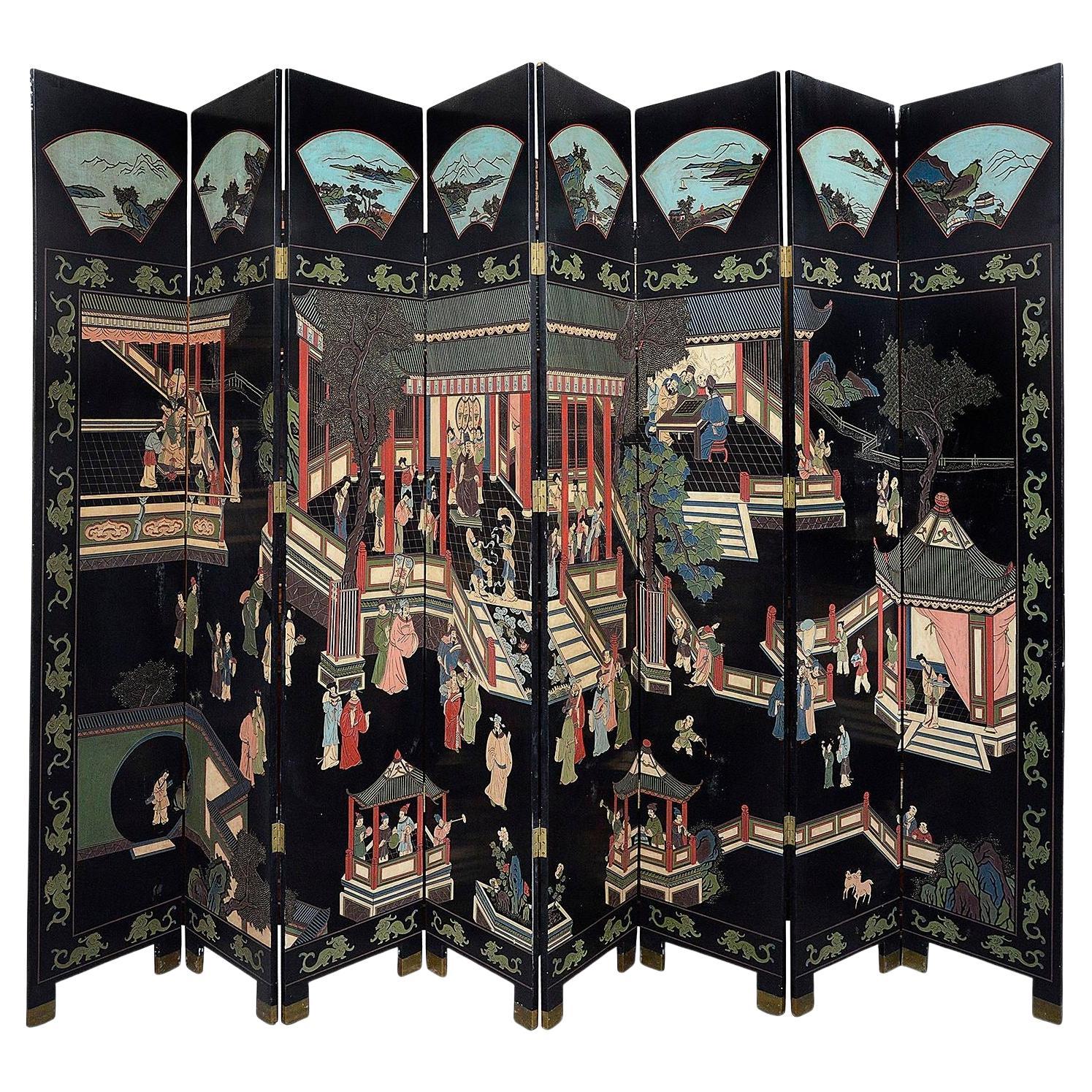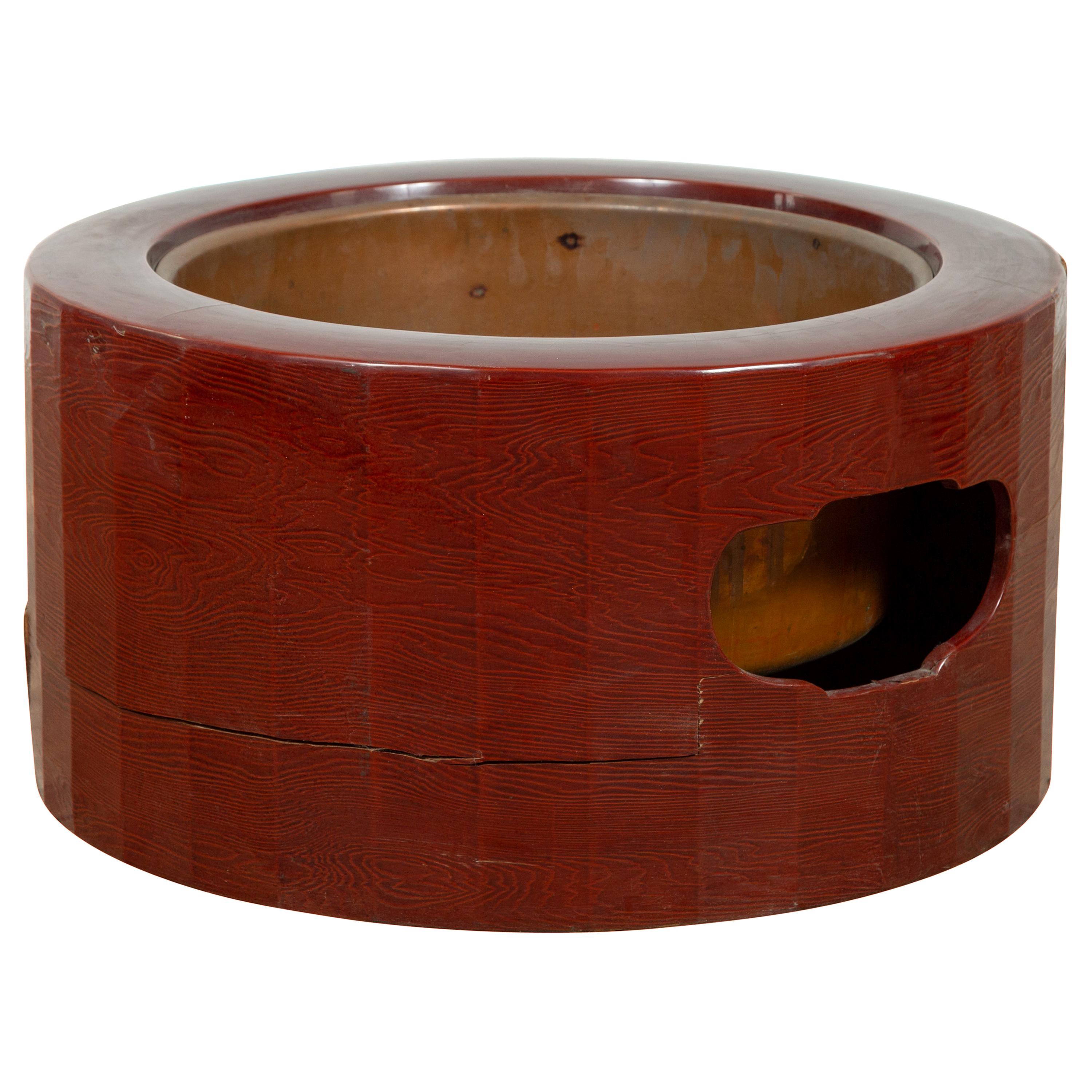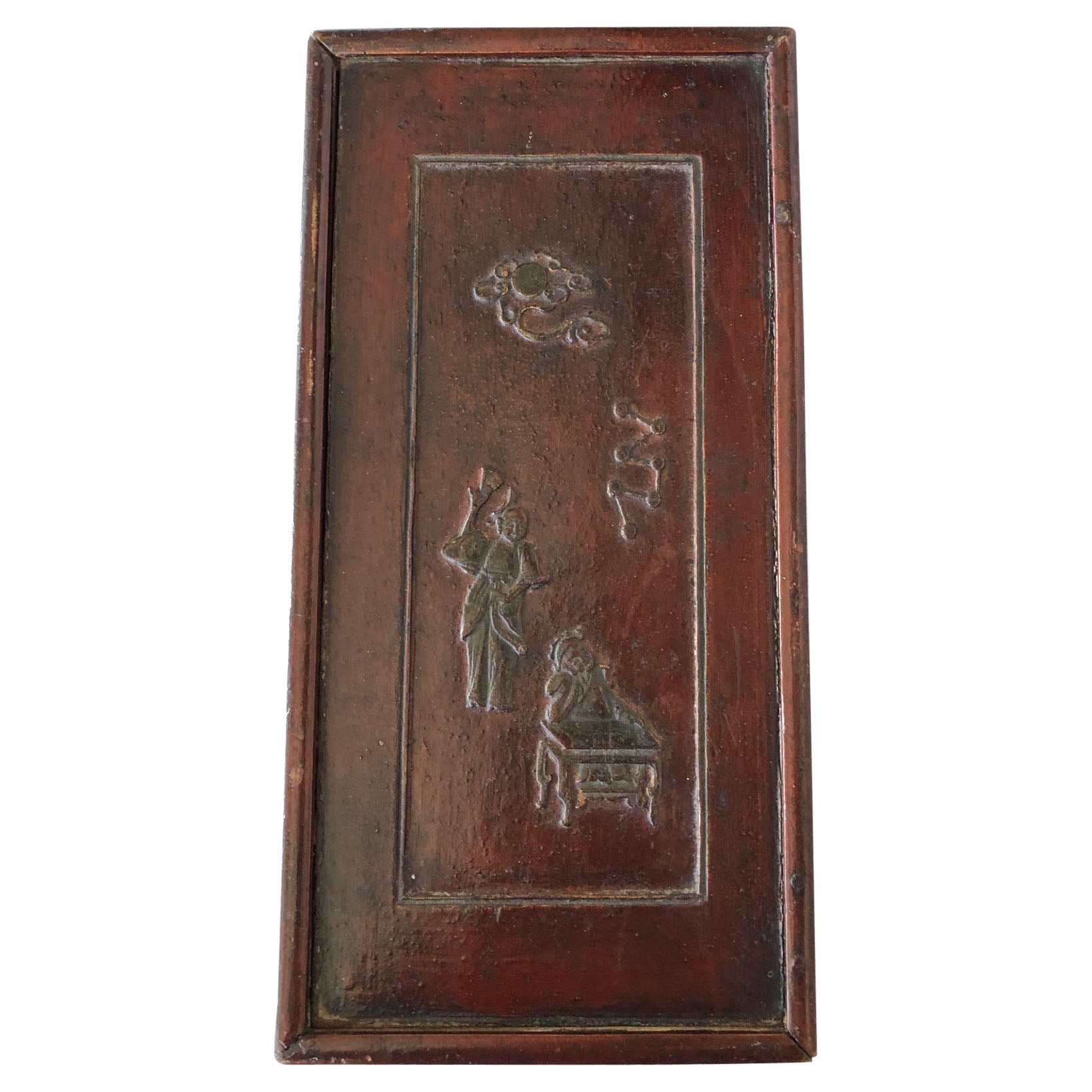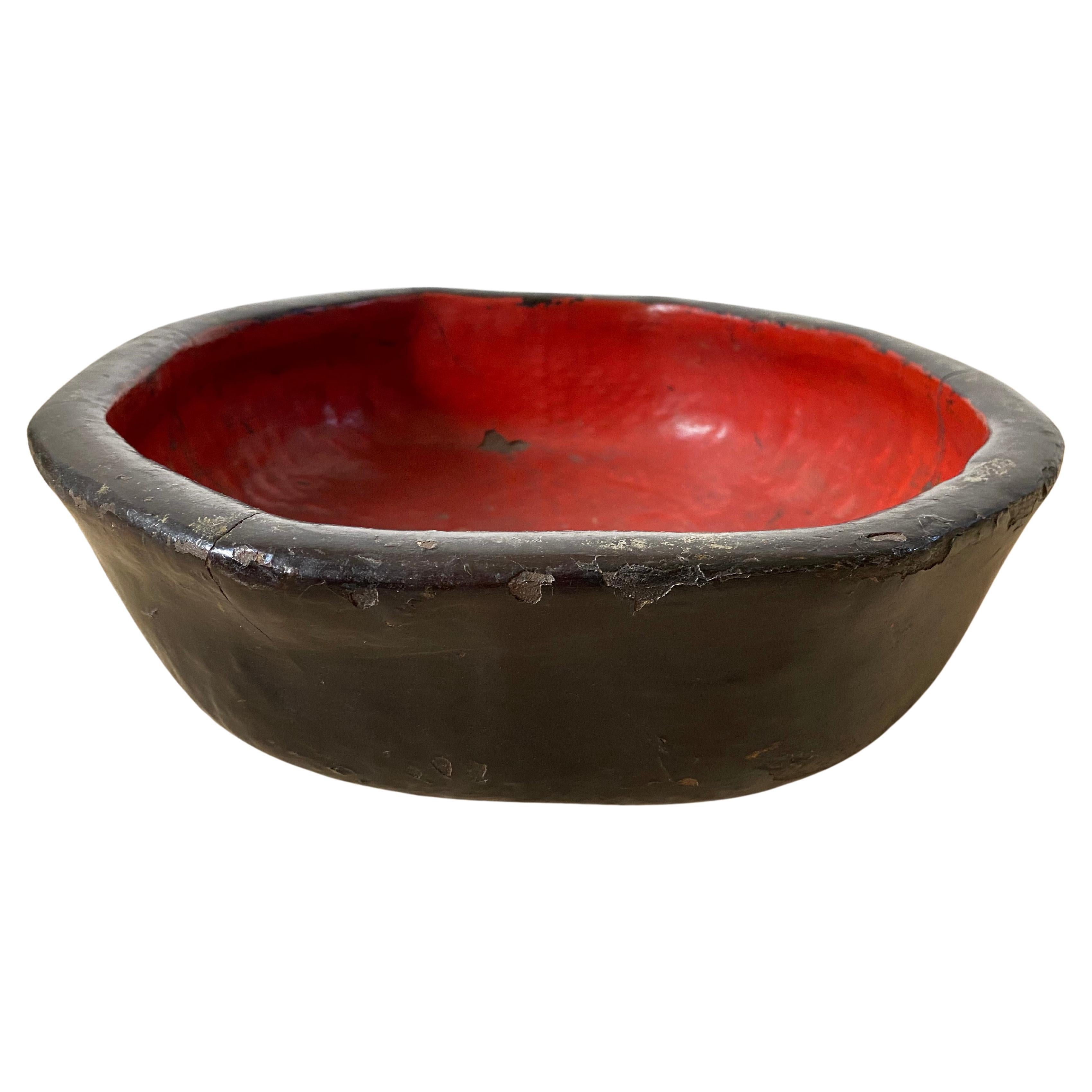Items Similar to Coromandel Black Lacquer Screen - Four Panels - Period: Early 20th Century
Want more images or videos?
Request additional images or videos from the seller
1 of 10
Coromandel Black Lacquer Screen - Four Panels - Period: Early 20th Century
About the Item
Elegant folding screen painted in black Coromandel lacquer.
It consists of four panels, the front of which depicts a scene from imperial life.
We are in the playground of a school where the children are having fun imitating their elders in their everyday tasks, fishing, war, music and also taming the four elements, earth, fire, air and water.
The reverse shows a magnificent scene of cranes, emblematic birds that symbolise longevity, resting on bamboo.
Period: Early 20th century
Dimensions: Height: 183cm x Width: 165cm x Thickness: 2.8cm
Leaf dimensions : Height : 183cm x Width : 40,8cm x Thickness : 2,8cm
The type of lacquer known as "Coromandel" was created in China around the middle of the 17th century. Their name, that of the east coast of India, was given by the English because it was in the ports of this coast that these lacquers were exported from China to Europe.
In the 17th and 18th centuries, Chinese junks were transhipped onto the ships of the East India companies. These were cabinets and, above all, vast screens of twelve sheets, up to 3 metres high and 60 centimetres wide for each sheet.
They were originally presented in China as gifts to high dignitaries.
From the reign of Kangxi onwards, they became export items and became very popular in Europe.
Many of them were dismembered on arrival and cut into panels to decorate chests of drawers.
The technique ushered in a new decorative style. The wood was covered with a thin fabric, held together by a carefully smoothed coating of vegetable glue and pulverised shale. The plain lacquer, almost always black, sometimes brown and more rarely red, is then applied in successive layers about 3 millimetres thick.
The decoration, surrounded by deep incisions and modelled in hollows, is then painted using matt coloured pigments in green, red, blue and white, often accompanied by gold, which contrast with the gloss of the lacquer.
The finest screens, some of which are dated, feature vast scenes with lively figures or large-scale landscapes.
They occupy the entire surface, with the exception of wide borders usually decorated with auspicious symbols.
Production continued in the 19th century, but with drier, more cluttered designs.
Our folding screen has been fully restored in our workshops.
- Dimensions:Height: 65.36 in (166 cm)Width: 64.97 in (165 cm)Depth: 0.79 in (2 cm)
- Style:Chinese Export (In the Style Of)
- Materials and Techniques:
- Place of Origin:
- Period:
- Date of Manufacture:XXth
- Condition:Refinished.
- Seller Location:CRÉTEIL, FR
- Reference Number:1stDibs: LU7814236513102
About the Seller
4.0
Vetted Seller
These experienced sellers undergo a comprehensive evaluation by our team of in-house experts.
1stDibs seller since 2022
9 sales on 1stDibs
Typical response time: Several days
- ShippingRetrieving quote...Ships From: CRÉTEIL, France
- Return PolicyA return for this item may be initiated within 14 days of delivery.
More From This SellerView All
- Old Castelet Or Guignol Theater, Period: Early 20th CenturyLocated in CRÉTEIL, FROld castelet or theater Guignol of parquet floor or living room Lyonnais. Its structure is in painted wood, the bottom represents a clown, the Auguste giving food to his playmate, a...Category
20th Century European Other Carnival Art
MaterialsWood
- Gilt Bronze Paper Cut - Maurice Frécourt - Period: Early 20th CenturyBy Maurice FrecourtLocated in CRÉTEIL, FRGilt bronze paper cup showing an eagle with outstretched wings. Maurice Frécourt began working in 1890, a date often wrongly given as his birth date. His y...Category
20th Century French Other Letter Openers
MaterialsBronze
- Bi Disc Sculpture - Brown Jade - Orange - Period: Early 20th CenturyLocated in CRÉTEIL, FRBi or Pi discs (as they are known in the West) are generally made of jade. Jade is China's most precious stone, and is also the stone of immortality (a material of unalterable hardne...Category
20th Century Chinese Other Mounted Objects
MaterialsJade
- Blown Glass Ewer - Murano - Art Nouveau - Period: Early 20th CenturyLocated in CRÉTEIL, FRBeautiful ewer in white Murano glass, blue and red watermarked, mouth-blown. Until the 17th and 18th centuries, ewers were used to serve drinks. Generally made of gold or silver precious metal, finely sculpted and chased, it takes the form of an elegantly shaped vase, generally taller than it is wide, mounted on a foot, with a spout and handle. Its name comes from the word aigue, meaning water in Old French (as does the locality of Aigues-Mortes). The ewer was widely used throughout the Middle Ages and the Renaissance. In the 18th century, it was replaced by the crystal carafe and the earthenware water jug. The water jug was originally designed to serve water on tables. It was also used for washing. Period: Early 20th century Dimensions: Height: 33cm - Width: 16cm Filigree glass is the French translation of the old Venetian term "vetro a filigrana"; this name covers a range of transparent blown glass varieties in which stretched glass threads ("canne") in white or various colors are incorporated. "Latticino" or "Latticinio" is an Italian term that has fallen into disuse and also designates "vetro a filigrana". This generic term covers three different types of decor: "vetro a fili", in which the "canes" form parallel lines; "vetro a retorti...Category
20th Century Italian Art Nouveau Glass
MaterialsGlass
- Polychrome Chromolithography - Virgin Of The Rosary - Period: Early 20th CenturyLocated in CRÉTEIL, FRA delightful polychrome chromolithograph depicting the statue of the Virgin and Child crowned and dressed in embroidered silk, carrying bunches of flowers. It is presented in a very attractive burr cedar frame that enhances the blue and white tones worn by the Virgin and Child. Period: Early 20th century Dimensions: Height: 56.5cm x Width: 46.5cm x Depth: 2cm From the Greek lithos...Category
20th Century French Other Posters
MaterialsPaper
- Table Feathers Glued On Canvas - Cockfight - Japan - Period: Early 20th CenturyLocated in CRÉTEIL, FRA beautiful Japanese creation made from glued butterfly feathers, depicting a cockfight. On this beautiful woven canvas, their feathers in shimmering colours illuminate the scene and...Category
20th Century European Other Decorative Art
MaterialsOther
You May Also Like
- Chinese Coromandel Lacquer Eight Fold Screen, Early 20th CenturyLocated in Brighton, SussexA very good quality early 20th century Chinese Coromandel lacquer eight fold screen. Depicting a classical Pagoda buildings with numerous courtiers wondering around. Bordered with fa...Category
Early 20th Century Chinese Lacquer
MaterialsLacquer
- Large 20th C. Chinese 6 Panel Lacquered Hardstone and Jade Coromandel ScreenLocated in New York, NYA large 20th century Chinese six panel Lacquered Hardstone and Jade Coromandel screen. This screen features intricately carved hardstone, soapstone, jade, lapis, quartz, and other ha...Category
20th Century Chinese Qing Lacquer
MaterialsStone, Jade, Lapis Lazuli, Soapstone
- 19th Century Parisian 10 Panel Coromandel Lacquer Chinoiserie Screen C.1850Located in Vancouver, British ColumbiaFabulous 10 panel coromandel lacquer 19th century Chinese Screen from Paris. Has beautifully detailed handpainted design with original cast...Category
Antique 1850s European Lacquer
MaterialsLacquer
- Japanese Taishō Period Early Red Lacquered Circular Hibachi, Early 20th CenturyLocated in Yonkers, NYA Japanese Taisho period circular red lacquered hibachi from the early 20th century, with metal liner and lateral handles. Used for cooking or w...Category
Early 20th Century Japanese Taisho Lacquer
MaterialsMetal
- Early 20th Century Chinese Red Lacquer Decorated BoxLocated in San Francisco, CAEarly 20th century Chinese Red Lacquer decorated box. Relief carved top panel of an attendant and scholar. Fine finger joints on the box and lid. Inside top of the lid having Chinese...Category
Early 20th Century Chinese Chinese Export Decorative Boxes
MaterialsWood, Lacquer
- Japanese Red & Black Lacquer Bowl, Early 20th CenturyLocated in Jimbaran, BaliA Japanese red & black lacquer bowl from the early 20th century. Its frame is crafted from woven rattan fibres and covered in multiple layers of lac...Category
Early 20th Century Japanese Other Decorative Bowls
MaterialsRattan, Lacquer
Recently Viewed
View AllMore Ways To Browse
Large Japanese Lacquer Bowl
Cloisonne Vase Buddha
Urushi Tray
Antique Japanese Fan Box
Japanese Mother Of Pearl Antique
Cockerel Seal
Black Lacquerware
Temple Ranma Panel
Tomizo Saratani
Bone Inro
Divider Laque
Hokkai Boxes
Japanese Bone Inro
Kamakura Bori
Korean Chest Shell
Midcentury Black Lacquer Inlay Wall Art
Peranakan Mirror
Red Wooden Wash Basin





